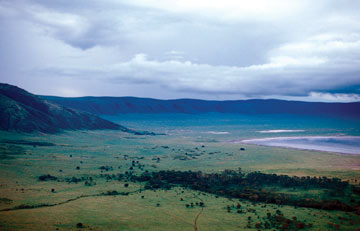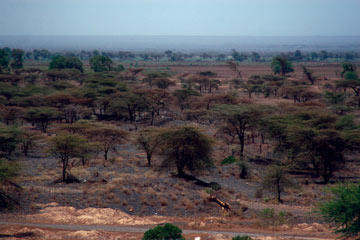|
FEATURE
Rocking the Cradle of Humanity:
Beth Christensen and Mark Maslin
We are all curious about our origins. How did our relatives end up in this country or that city? But some of us want to go back even further to understand our earliest origins. From where did this strange, intelligent naked ape appear? Why did it begin to walk upright? And why does it have a brain large enough to ponder these questions?
Over the last decade, progress has been made on answering these questions as paleoanthropologists and paleoclimatologists have joined forces. One of the major debates is whether tectonics drove climate, which then drove evolutionary changes in our lineage, or whether climate and tectonics drove evolutionary changes separately. The latest research, published in 2007 in a special issue of the Journal of Human Evolution, provides the basis of a new vision of early human evolution. It suggests that tectonics made East Africa highly sensitive to climate changes. As a result of the formation of the Rift Valley, shifts in global climate caused brief periods during which huge lakes appeared and disappeared in East Africa. These rapid shifts from very wet to very dry may have been the environmental stress necessary to push our ancestors down a human path.
Evolutionary Theories for Hominin Evolution
Although climate or tectonic changes can be examined at every branch on the human evolutionary tree, we are focusing on our early African ancestors over the last 7 million years. Climate has long been postulated as one reason for evolutionary change. However, the simple picture of a changing climate altering the landscape from rainforests to grasslands, and thus causing early hominins to climb out of the trees and start to walk upright across the new savannas, is growing more complicated. Two long-held hypotheses — the Turnover Pulse Hypothesis and the Variability Selection Hypothesis — seem no longer capable of telling the whole story.
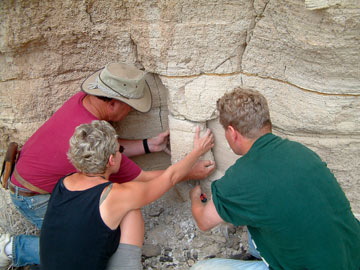 Mark Maslin and Beth Christensen |
| Many paleolake deposits found in East Africa have annual laminations, which have shown that there are lots of interannual variations that may be linked to the start of El Niño sometime after 2 million years ago. The onset of these variations correlates to changes in human evolution. |
The Turnover Pulse Hypothesis invokes a major change in climate, from woodland to savanna, as the dominant reason for changes leading to the evolution of the species Homo nearly 2.5 million years ago. In 1985, Elizabeth Vrba of Yale University in Connecticut, showed a significant shift in the morphology of bovids — from woodland/forest species to those found in a more open environment — and made a compelling argument that increased aridity led to widespread grasslands in southern Africa around 2.7 million years ago, around the time big ice ages started in the Northern Hemisphere. The hypothesis postulates a shift from hominins such as australopithecines who were still at home in the trees to the more fully erect species of Homo better adapted to life on the plains.
This idea of climate change forcing morphological adaptation is also key to the related “savanna hypothesis,” the idea that the incredible change in the landscape of East Africa sometime after 6 million years ago caused the earliest hominins to evolve bipedalism. Before this time, food was plentiful in the rainforest. After this time, though, the hypothesis goes that the spread of grasslands broke up the forest and forced adaptation. For an ape, walking upright is an extremely efficient way of covering vast distances between food sources, which may have been scarce after the vegetation shift.
However, the story is probably not that simple, as early bipedal hominins such as Ardipithecus ramidus or Australopithecus afarensis have been found as far afield as Ethiopia. The savanna hypothesis implies that hominin evolution occurred first in East Africa with subsequent migration. But the fossil record is so sparse and difficult to date that it is next to impossible to confirm whether fragmenting of the East African landscape really led to our ancestors getting up and starting to walk.
Another issue is that grasslands existed well before major evolutionary changes in the hominin lineage (8 million years ago in eastern Africa, 7 million years ago in central Africa, 5 million years ago in southern Africa), as shown by Loic Ségalen of the University of Pierre and Marie Curie in Paris and colleagues. However, because grasses did not fully dominate these landscapes until much later, Ségalen concluded that the early presence of these grasses allowed for experimentation and adaptations that may have been employed later, when grasslands began to dominate the ecosystem. So it seems that as grasslands appeared, hominins were taking advantage of new opportunities, but the appearance of grasslands alone was probably not enough to cause bipedalism (nor a major turnover of new hominin species).
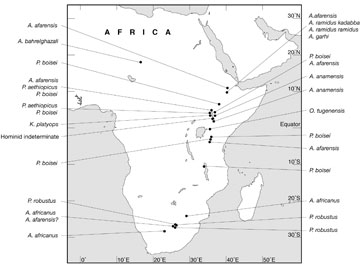 Mark Maslin and Beth Christensen |
| Most early hominin fossils discovered in Africa are along the East African Rift, which runs 6,000 kilometers north-south and 600 kilometers east-west. |
In contrast to the idea of a significant one-directional climate change leading to significant evolutionary changes that the Turnover Pulse Hypothesis purports, the Variability Selection Hypothesis requires climate change on a much more rapid time scale and without consistent pressure in the same direction. It states that dramatic and frequent climate changes drove adaptations that enabled individuals to cope with a wide range of environmental conditions. These frequent climate changes thus drove hominins to evolve ways to better adapt to a variable environment. Indeed, the fossil record reveals two methods adopted by different hominin species: brain expansion to think and manage environmental stresses, and massive jaws to eat anything, whatever the conditions.
An example of such rapid climate change is El Niño-Southern Oscillation (ENSO), which currently has a major influence on East African climate. However, for there to be a strong ENSO, there needs to be a strong east-west atmospheric circulation called Walker Circulation. About 2 million years ago, Walker Circulation intensified to its modern level and may mark the start of ENSO. This would have resulted in extreme annual variations in local and regional climates from 2 million years ago onward, which correlates with the first appearance of Homo erectus and the last occurrence of Australopithecus africanus. Another example is the periodic extreme climate change that can come from orbital forcing, the wobble of Earth on its axis of rotation and orbit around the sun. Geologists have known for decades that orbital forcing controls the waxing and waning of ice ages, but we now realize that it may have profoundly affected tropical climates as well. The excellent stratigraphy available for the East African sites has allowed researchers to document the link between orbital forcing and ancient lake levels.
No doubt rapid climate changes played a major role in speciation, causing adaptive responses to severe shifts in moisture availability and the consequential changes in the ecosystems. The onset of Walker Circulation around the end of the Pliocene seems to have modified the response throughout the continent. For example, in southern Africa, the mixture of woodland-dominated and grass-dominated plants present through the Pliocene is replaced at that time by a system dominated by grassy plants, as Phil Hopley of University College London in the United Kingdom and colleagues have shown. Recent studies also highlight the extreme climate variations found within East Africa and strong correlations with morphologic changes in hominins. For example, Christopher Campisano of the Smithsonian National Museum of Natural History in Washington, D.C., and Craig Feibel of Rutgers University in New Jersey link morphologic changes in Australopithecus afarensis and aridity around 3.15 million to 2.95 million years ago, as indicated by multiple climate proxies. And Christopher Lepre of Rutgers and colleagues show high variability climate oscillations around the time of the emergence of Homo erectus 1.6 million years ago.
| The formation of the East African Rift may have caused climatic changes that gave rise to human evolution. |
However, we are quickly learning that quite a bit of what we have previously interpreted as climatic in nature may be primarily controlled by tectonic changes. So, we need to take into account tectonic forcing — in the form of the rise of Africa’s most varied topography.
Tectonics and the building of the cradle
Recent studies show that tectonics modulates local climate, especially in East Africa. The formation of the East African Rift Valley between 10 million and 5 million years ago forever changed Africa’s landscape and climate and, it seems, the course of human evolution. In less than 5 million years, East Africa went from a relatively flat area with abundant rainforests to a region of extreme topography. As the rift opened, a region of mountains, plateaus and deep rift valleys formed, creating the so-called cradle of humanity.
The newly formed East Rift shoulder, or mountain range, prevented moist air from the Indian Ocean from passing over East Africa and significantly dried the other side of the mountains. This combination of topography and aridity shifted vegetation, which produced a climate that varies from cloud forest to desert scrub across the rift. On a local scale, Rhonda Quinn of Rutgers and colleagues have shown that in Koobi Fora in Kenya, grasses appeared later than in the rest of the region, likely driven by tectonic changes that altered the local hydrology. Without considering tectonic changes and the evolution of the East African Rift, sedimentary records in this area might be misinterpreted as primarily forced by global climate change. On a regional scale, too, the impact of tectonics is not straightforward. This is clearly illustrated by the large lakes of East Africa, which developed as the East African Rift developed.
We’ve known that the rise of the mountain ranges caused aridity changes for awhile, but the relationship between orbital forcing, the tropics and moisture availability in the East African Rift Valley is new and quite exciting. It also sheds light on potential causes of changes in hominin evolution.
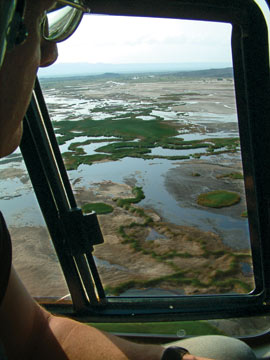 |
| Water is rare in northern Kenya today and this water seen on the recent expedition to Suguta Valley disappeared within two days. Researchers had to use helicopters to reach the sites. |
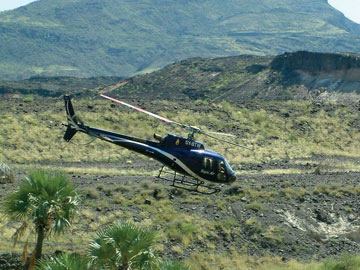 Both photos by Mark Maslin and Beth Christensen |
Pulsed Climate Variability, a unifying theory
What’s needed, then, is a hypothesis that combines tectonic forcing with climate variability, thus linking orbital variation and the new topography. Enter the Pulsed Climate Variability hypothesis as suggested by Martin Trauth of the University of Potsdam in Germany and Mark Maslin.
Over the last 3 million years, the East African Rift Valley has become more arid, but we now know that this long-term trend was punctuated by short episodes of alternating periods of extreme wetness and aridity. Using detailed analyses and excellent stratigraphy, John Kingston of Emory University in Georgia and colleagues have found an extreme change in lake levels in the Baringo Basin in Kenya between 2.7 million and 2.5 million years ago at a precessional scale (about 21,000 years).
Such periods of extreme climate variability occurred three times in the last 3 million years. Trauth and his colleagues suggest that each of these periods coincided with a major global climate change during which East Africa became more locally sensitive to orbital forcing at precessional scales. This resulted in rapid shifts from wet to dry conditions, as moisture from the tropics alternately was available or denied to the rift valley, depending on orbital configurations. These periods of “pulsed climate variability” are characterized by the precession-forced appearance and disappearance of large, deep lakes in the East African Rift Valley. These lakes were huge and deep — well over 1,000 square kilometers and 300 meters deep. Trauth and his colleagues are continuing this work on large paleolakes found in the Suguta Valley in northern Kenya by trying to establish how quickly these large lakes appeared and disappeared. Their results show that the scale of Paleo-Lake Suguta is astonishing — only 13,000 to 10,000 years ago, there was a lake 300 meters deep covering 1,600 square kilometers.
Significantly, over the last 3 million years, such periods are focused at times of major global climatic transitions, such as the intensification of Northern Hemisphere glaciation 2.7 million years ago, the onset of Walker Circulation 2 million years ago and the mid-Pleistocene Revolution 1 million years ago — during which the ice ages started to become more intense and longer. These periods of pulsed climate variability may have provided a catalyst for evolutionary change and driven key speciation and dispersal events among mammals and hominins in Africa. In particular, hominin species seem to differentially originate and go extinct during periods of extreme climate variability. Although representing less than a quarter of the total period of highly variable East African climate, or pulsed climate variability, 12 out of the 15 known hominin speciations occurred between 5 million and 500,000 years ago.
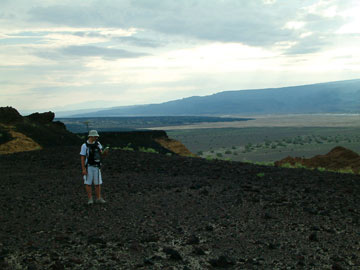 Mark Maslin and Beth Christensen |
| Despite the aridity of modern East Africa, in the past, much of the region has been covered with large lakes that have come and gone. Many of these paleolakes correlate with key steps in human evolution. One of the tasks of the recent expedition to the Suguta Valley was to map all of the old lake shorelines, such as the one pictured here. |
Thus, the evidence seems to be leading us to believe that not only is highly variable climate associated with evolutionary innovation, but that pulsed climate variability is a mechanism for focused periods of innovation, whereby orbitally forced rapid climate changes are separated by periods of relatively reduced amplitude change. Furthermore, the evidence suggests that such climate changes would never have had the same extreme effect if it were not for the tectonic disruption, as the East African Rift formed.
Tectonics can thus be seen as a fortuitous intervention in human history, allowing orbitally forced tropical moisture changes to become a potent focusing mechanism in our evolutionary pathway. Local climate responses to these tectonic changes were likely amplified by the onset of Walker Circulation and modulated by precessionally forced variations in moisture availability, at least in East Africa. As a result, speciation also seems to have been earlier, and maybe even faster, in eastern Africa than in more stable southern Africa. However, the climate of southern Africa is not well-defined for the late Cenozoic, and we are just now beginning to assemble a detailed history of this complex region. The “Pulsed Climate Variability” hypothesis thus integrates climate variability with major climate events, and provides a potential explanation for the rapid evolutionary innovation during this time period. Whether this directly led to speciation in East Africa, and later migration out of Africa, is still a major question.

 Subscribe
Subscribe

